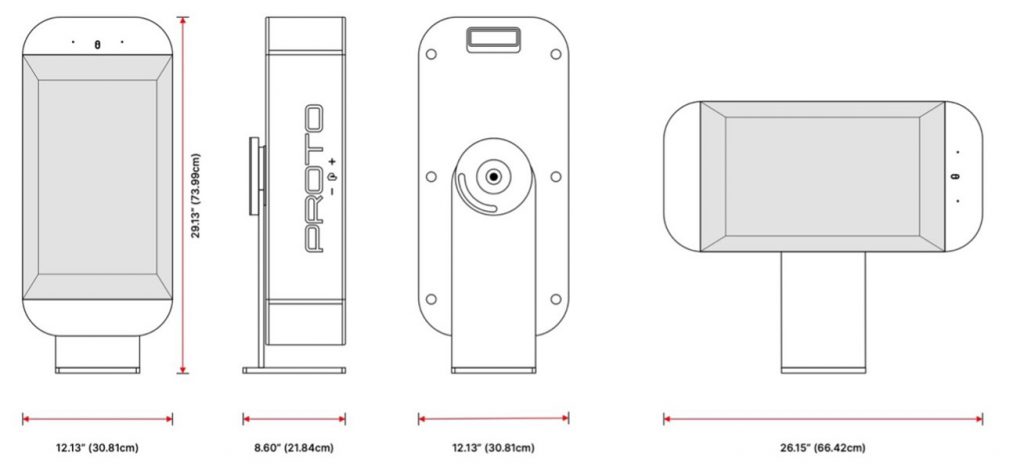Imagine being a rural clinician treating a patient hundreds of kilometres away from the nearest specialist, but you need help and expert advice now. Traditionally, you could rely on phone calls or video calls to explain the patient’s condition and the complications facing you. But what if a life-sized three-dimensional (3D) specialist was in the room to provide that support? Or what if the specialist could see a life-sized 3D view of the patient you are treating? This is the promise of holographic technology, and its potential application across Queensland’s healthcare system is already sparking conversations.
Our team from the Queensland Innovation Living Lab (QuILL) recently explored the potential for holography in healthcare. Recent use of the Proto M holographic device in the Queensland Department of Education prompted the question of how to, and where, this technology could be translated to healthcare, particularly to support telehealth delivery and education. Our goal was to understand how healthcare professionals perceive this technology and where it might best fit into their work and also how health planners perceive this technology could be introduced to support system, service and facility re/design.
What is holography, and how could it help in healthcare?
Holography builds on augmented and virtual reality by creating 3D visualisations that feel immersive and interactive. Imagine a rectangular box with a touchscreen capable of projecting live or pre-recorded 3D images. Clinicians could simulate physical exams, teach complex medical techniques, or connect with patients remotely in ways traditional screens cannot replicate.
How did we evaluate holography?
In our trial, the Proto M device was set up in the foyer of a Department of Health building, allowing over 20 staff members to interact with it. Participants shared their thoughts about its potential uses, ease of operation, and challenges, helping us to uncover where holography might have the most impact in healthcare.

Use case suggestions
When we asked staff consider the potential applications for holography in healthcare, they were quick to brainstorm. Some standout ideas included:
- Telehealth Reinvented: Imagine holographic consultations for remote areas, where doctors could conduct virtual physical exams or demonstrate medical procedures with clarity and depth.
- Realistic Training and Education: Clinicians identified huge potential for hands-on training, from nurses teaching blood pressure monitoring to pharmacists explaining self-administered medication processes.
- Group Rehabilitation: Picture patients participating in holographic cardiac rehab sessions from their own communities, guided by specialists as though they were in the same room.
“This isn’t just a tool for convenience—it’s a way to save money, time, and improve care, especially for people in rural and remote areas.”
Recognising the challenges and limitations
While the Proto M sparked excitement, this project also raised critical questions about its feasibility and viability for real-world use in healthcare.
For instance, the setup we tested involved participants in the same room, leaving unanswered questions about the technology’s practicality for two-way communication in remote scenarios. The potential need for a dedicated studio setup to present high quality images of patients and clinicians could introduce logistical and operational challenges.
Participants also highlighted the importance of appropriate visual and audio quality for ensuring usability in clinical contexts. As one clinician noted:
“Any technology we use to bring specialists to rural and remote areas must have a visual standard that lets us look at arms, not just a talking head on a Zoom screen.”
These insights emphasise the need for further investigation to explore whether holography can meet the demands of our diverse clinical environments.
Shaping the future of healthcare – Where to from here?
Innovation is not just about technology—it’s about transforming how we deliver care and empowering those who use it. At QuILL, we imagine a world where healthcare providers, patients, and consumers are active co-designers in the development and selection of medical devices and software. By involving users at every stage, we can ensure solutions are not only cutting-edge but also practical, intuitive, effective, and valuable.
This project highlights the importance of usability testing as a cornerstone of innovation. Understanding how users interact with technology in real-world scenarios is critical to identifying what works, what doesn’t, and what could be improved. As we continue to explore the potential of technologies like holography, our focus will remain on rigorous evaluation and co-design to ensure these innovations truly meet the needs of clinicians and patients alike.
Stay tuned for future insights, where we will take you inside the Living Lab to show you how we test, refine, and collaborate to create meaningful solutions for healthcare. Together, we are building a better future—one test at a time.
Join the conversation
Holography offers a glimpse into the future of healthcare but making it a reality will take collaboration. Are you interested in exploring how this or other technologies could impact your work?
Let’s talk. Together, we can bring healthcare innovation to life!
Thank you to the Department of Health's Gary Waldon - Program Director, Digital Health and Business Solutions, eHealth Queensland and Samantha Prime - Director, Healthcare Improvement Unit, Clinical Excellence Queensland for sparking this Digital Discovery.














